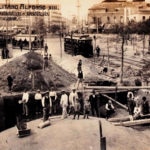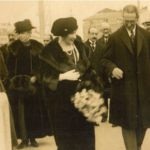100th anniversary of the Madrid Metro: BBVA was the only bank to bet on the project
The Madrid Metro celebrated its 100th anniversary, bringing its one million daily passengers closer to the Spanish capital in a quick and sustainable manner. BBVA is especially pleased to join the centennial anniversary of its opening, made possible thanks to the financial support provided by the Banco de Vizcaya despite investors’ suspicion of this novel and pioneering form of transportation.

It is the 100th anniversary of a milestone in Madrid’s history. On October 17, 1919, King Alfonso XIII attended the official opening of Madrid’s metro, putting a new, faster and modern form of transportation within everyone’s reach.
Several days later, on October 31st, the Madrid Metro opened its doors to the public, allowing 56,200 people to travel by subway for the first time. The North-South line covered 3.48 kilometers, with eight stations that connected Cuatro Caminos with Sol in just 10 minutes. A century later, the metro has a total of 294 kilometers, 302 stations and 626 million passengers per year.
The Madrid Metro, one of the largest metropolitan networks in the world after London, Paris and Moscow, has grown along with the city and has witnessed an endless number of events - both mundane and historic. For example, it served as a refuge during the Spanish Civil War and its engine building provided electricity when power outages took place during this period.

Enrique Ocharan, managing director of the Banco de Vizcaya, accompanying Queen Victoria Eugenia in her first visit to the metro.
Next stop: Madrid
The idea of building a railroad dates back to 1886 under the leadership of the engineers Miguel Otamendi, Carlos Mendoza and Antonio González Echarte, although it wasn’t until 1917 when it started to take shape. However, getting this means of transportation up and running was not easy. The company commissioned to carry out the project, la Compañía del Metropolitano Alfonso XIII, had a hard time getting financing for the construction due to the skepticism and uncertainty surrounding the initiative.
What was known as Banco de Vizcaya at the time, one of the main founding banks of the current BBVA, was the only financial group that took a chance on the project, granting the company a loan. Therefore, on January 19, 1917, the Banco de Vizcaya’s board, chaired by the managing director Enrique Ocharan, agreed to grant Compañía del Metropolitano Alfonso XIII four million pesetas for the construction project.
This guaranteed 50 percent of the capital needed to build the first section. The entire construction project would cost a total cost of eight million pesetas (currently equivalent to €50,000). Several documents saved in BBVA’s historical archives attest to Banco de Vizcaya’s support for the project, and the agreement to grant the loan. There are even photographs of Enrique Ocharan accompanying Queen Victoria Eugenia in her first visit to the metro.
The remaining capital needed to complete the construction was obtained thanks to a million peseta contribution from King Alfonso XIII. This gesture convinced the other investors, who provided the remaining money needed to financially guarantee the project and give the green light for construction to begin. Thus, this financing gave life to the pioneering project, which is currently part of Madrid’s identity.